A Beginner’s Guide to the OUTPUT Clause in SQL Server
原文 A Beginner’s Guide to the OUTPUT Clause in SQL Server
T-SQL supports the OUTPUT clause after the inception of SQL server 2005 and later editions. We can use the OUTPUT clause with DML statements (INSERT, DELETE, UPDATE) to return information from modified rows.
We primarily use the OUTPUT clause for auditing and archiving modified rows. In this tutorial, we will walk through the use of the OUTPUT clause with different DML statements and examples. First, we will create a table, dbo.Songs, and populate it with some data.
IF OBJECT_ID('dbo.Songs') IS NOT NULL
DROP TABLE dbo.Songs
GO
CREATE TABLE dbo.Songs
(
Id int CONSTRAINT PK_Songs_Id PRIMARY KEY,
Name varchar(200) NOT NULL,
Singer varchar(50) NOT NULL
)
GO
INSERT INTO dbo.Songs ( Id, Name, Singer)
VALUES (1, 'I hate everything about you', 'Adam Gontier');
INSERT INTO dbo.Songs ( Id, Name, Singer) VALUES (2, 'Dil se', 'A. R. Rahman');
INSERT INTO dbo.Songs ( Id, Name, Singer) VALUES
(3, 'My heart will go On', 'Celine Dion');
INSERT INTO dbo.Songs ( Id, Name, Singer) VALUES (4, 'Maeri', 'Euphoria');
GO
SELECT * from dbo.Songs
GO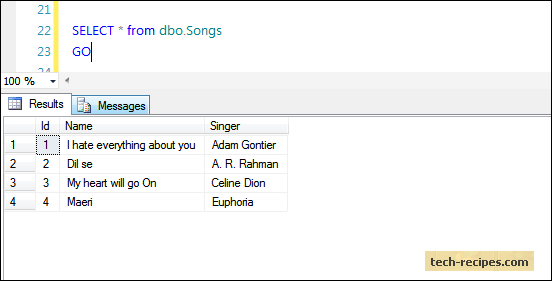
Inserted and Deleted Tables in an OUTPUT Clause
Inserted and Deleted tables are two memory-resident tables that reside within SQL server and are used with the OUTPUT clause.
Whenever any DML (INSERT, DELETE, UPDATE) statement is executed, these tables are populated.
The results of the INSERT statement are stored in the Inserted table, and the results of the Delete statement are stored in the Deleted table. Also, with an UPDATE statement, the deleted rows are stored in the Deleted table. The new inserted rows in the Inserted table as UPDATE are nothing but delete and insert operations combined together.
Note: You cannot directly query Inserted and Deleted tables to see what data they are currently holding, but you can use them with the OUTPUT clause as well as with Triggers.
The OUTPUT Clause with an Insert statement
When we do an Insert operation on a table, we get a message which reads, “(n row(s) affected),” but if we want to see what data rows were inserted into a table, we can use an OUTPUT clause and a memory resident inserted table to return the results back to the screen in the same way that a select statement does.
Let us insert a record, and use an OUTPUT clause to print the results on the screen.
INSERT INTO dbo.Songs ( Id, Name, Singer)
OUTPUT INSERTED.ID, INSERTED.name, INSERTED.Singer
VALUES (5, 'AINT no grave', 'Johnny Cash');
GOCheck the dbo.Songs table. A new row is inserted with id=5.
select * from dbo.Songs;
GO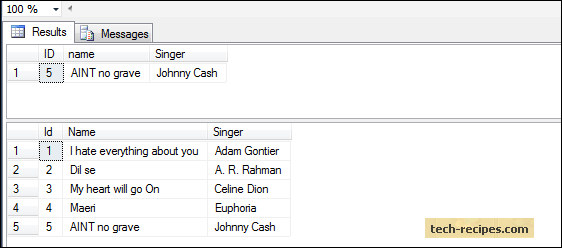
The OUTPUT Clause with a Delete Statement
The same goes with a delete operation. It shows only (n rows(s) affected). We can use an OUTPUT clause and a deleted table to see which rows were actually deleted from the table.
DELETE from dbo.Songs
OUTPUT DELETED.id, DELETED.name, DELETED.singer
WHERE ID=5;
GOQuery the dbo.Songs table row with id = 5 has been deleted.
select * from dbo.Songs;
GO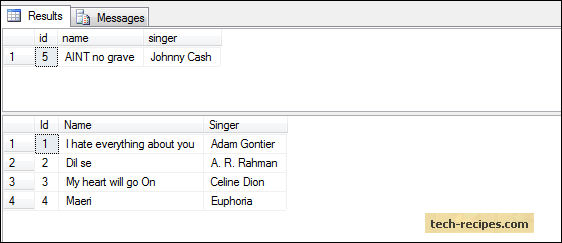
The OUTPUT Clause with an Update Statement
An Update statement does nothing but delete old data and insert new data, so with an Update statement, both memory resident tables are affected and are deleted as well as inserted.
Here we are updating the name of a singer, who has sung ‘Dil se’ song, with ID equal to two.
UPDATE dbo.Songs
SET Singer = 'Rahman'
OUTPUT DELETED.Singer, INSERTED.Singer
WHERE ID = 2;
GOYou can see the old singer’s name along with the new singer’s name.
select * from dbo.Songs;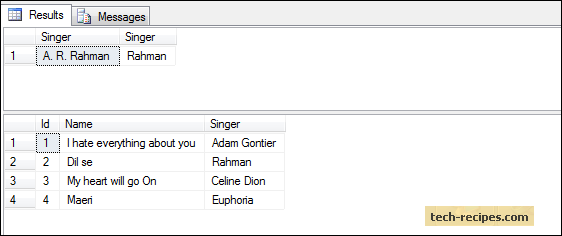
The three examples above show how to use an OUTPUT clause for auditing purposes. Now, we will see how to use it for archiving.
Before, we were just printing the results of a DML statement on the screen, which was temporary, but with the OUTPUT clause, you can store the results of a DML statement in a table, too.
Store Results of an OUTPUT Clause into a Table
Inserting the data return from an OUTPUT clause into a table can be done using an OUTPUT INTO clause. Keep in mind that you first need to create the target table which must have the same number of columns and data types that match the source table.
IF OBJECT_ID('dbo.Songs_Inserted') IS NOT NULL
DROP TABLE dbo.Songs_Inserted
GO
CREATE TABLE dbo.Songs_Inserted
(
Id int CONSTRAINT PK_Songs__Inserted_Id PRIMARY KEY,
Name varchar(200) NOT NULL,
Singer varchar(50) NOT NULL
)
GO
INSERT INTO dbo.Songs ( Id, Name, Singer)
OUTPUT Inserted.* INTO dbo.Songs_Inserted
VALUES (5, 'Duniya', 'Piyush Mishra');
GO
-- Result of Songs_Inserted table and base table.
select * from dbo.Songs_Inserted;
select * from dbo.Songs;
GO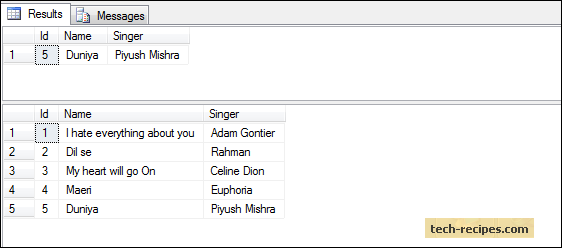
As the results above show, data is inserted into both the tables.
Store Results of an OUTPUT Clause into a Temporary Table
The same goes with a temporary table. Create a temporary table first, and then using an OUTPUT INTO clause, insert the data returned by the OUTPUT clause into a temporary table.
IF OBJECT_ID('tempdb..#Songs_Deleted') IS NOT NULL
DROP TABLE dbo.#Songs_Deleted
GO
CREATE TABLE dbo.#Songs_Deleted
(
Id int,
Name varchar(200) NOT NULL,
Singer varchar(50) NOT NULL
)
GO
DELETE from dbo.Songs
OUTPUT deleted.* INTO dbo.#Songs_Deleted
WHERE ID IN (4,5);
GO
-- Result of temporary table and base table.
SELECT * from dbo.#Songs_Deleted;
Select * from dbo.Songs;
Store Results of an OUTPUT Clause into a Table Variable
Nothing changes for table variables as well. Declare a table variable structure the same as a source table. Do not forget to run the entire script at once so that you can see the output inserted into a table variable.
Declare @Songs_Deleted TABLE
(
Id int,
Name varchar(200) NOT NULL,
Singer varchar(50) NOT NULL
)
DELETE from dbo.Songs
OUTPUT deleted.* INTO @Songs_Deleted
WHERE ID IN (1,2);
-- Result of table variable
SELECT * from @Songs_Deleted;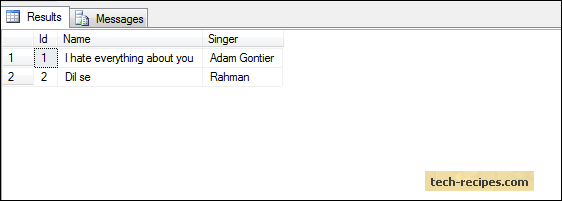
Browse through our SQL server archive articles for more useful information.
A Beginner’s Guide to the OUTPUT Clause in SQL Server的更多相关文章
- Guide to Database Migration from Microsoft SQL Server using MySQL Workbench
http://mysqlworkbench.org/2012/07/migrating-from-ms-sql-server-to-mysql-using-workbench-migration-wi ...
- A Beginner's Guide To Understanding Convolutional Neural Networks(转)
A Beginner's Guide To Understanding Convolutional Neural Networks Introduction Convolutional neural ...
- (转)A Beginner's Guide To Understanding Convolutional Neural Networks Part 2
Adit Deshpande CS Undergrad at UCLA ('19) Blog About A Beginner's Guide To Understanding Convolution ...
- (转)A Beginner's Guide To Understanding Convolutional Neural Networks
Adit Deshpande CS Undergrad at UCLA ('19) Blog About A Beginner's Guide To Understanding Convolution ...
- A Beginner’s Guide to Eigenvectors, PCA, Covariance and Entropy
A Beginner’s Guide to Eigenvectors, PCA, Covariance and Entropy Content: Linear Transformations Prin ...
- A Beginner's Guide to Paxos
Google Drive: A Beginner's Guide to Paxos The code ideas of Paxos protocol: 1) Optimistic concurrenc ...
- Beginner's Guide to Python-新手指导
Refer English Version: http://wiki.python.org/moin/BeginnersGuide New to programming? Python is free ...
- 新手教程之:循环网络和LSTM指南 (A Beginner’s Guide to Recurrent Networks and LSTMs)
新手教程之:循环网络和LSTM指南 (A Beginner’s Guide to Recurrent Networks and LSTMs) 本文翻译自:http://deeplearning4j.o ...
- Photography theory: a beginner's guide(telegraph.co.uk)
By Diane Smyth, Tim Clark, Rachel Segal Hamilton and Lewis Bush 11:00AM BST 09 Jun 2014 Have you r ...
随机推荐
- Spring 笔记(一)概念梳理
概念 预备知识 1. POJO POJO是Plain Old Java Object的缩写,是软件开发大师Martin Fowler提出的一个概念,指的是一个普通Java类.也就说,你随便编写一个Ja ...
- v-if与v-show区别
在v-show中,元素是一直存在的,当v-show为false时,元素display:none只是隐藏了而已. v-if 作用:判断是否加载固定的内容,如果为真,则加载:为假时,则不加载. 用处:用在 ...
- [poj] 1269 [zoj] 1280 Interesting Lines || 求两直线交点
POJ原题 ZOJ原题 多组数据.每次给出四个点,前两个点确定一条直线,后两个点确定一条直线,若平行则输出"NONE",重合输出"LINE",相交输出" ...
- POJ3252 Round Numbers 【数位dp】
题目链接 POJ3252 题解 为什么每次写出数位dp都如此兴奋? 因为数位dp太苟了 因为我太弱了 设\(f[i][0|1][cnt1][cnt0]\)表示到二进制第\(i\)位,之前是否达到上界, ...
- POJ3345 Bribing FIPA 【背包类树形dp】
题目链接 POJ 题解 背包树形dp板题 就是读入有点无聊,浪费了很多青春 #include<iostream> #include<cstdio> #include<cm ...
- uoj228:基础数据结构练习题
题意:http://uoj.ac/problem/228 sol :线段树开根操作 对于节点x,可以在max[x]-min[x]<=1时直接做,转化为区间减或区间覆盖 #include< ...
- mysql数据定期备份删除
1.这里只写备份mysql的数据库的方法,全备份,包括定时删除. 准备工作,弄一个文件夹存数据库备份数据 第一步:编写shell 脚本,命名为shell.sh #备份数据库 backupdir=/we ...
- em,rem
em rem 相对单位: 也可用于设置padding line-height等em相对当前容器的默认字体设置比如,所有浏览器默认字体都是16px,body{ font-size:62.5%}以后即1 ...
- 编写Shell脚本的最佳实践,规范二
需要养成的习惯如下: 代码有注释 #!/bin/bash # Written by steven # Name: mysqldump.sh # Version: v1.0 # Parameters : ...
- Selenium2 鼠标悬停效果实现
对一些js控件,鼠标悬停的时候出发下拉层的实现 1.使用Action public void moveToElement(WebDriver driver, By locator) { Actions ...
